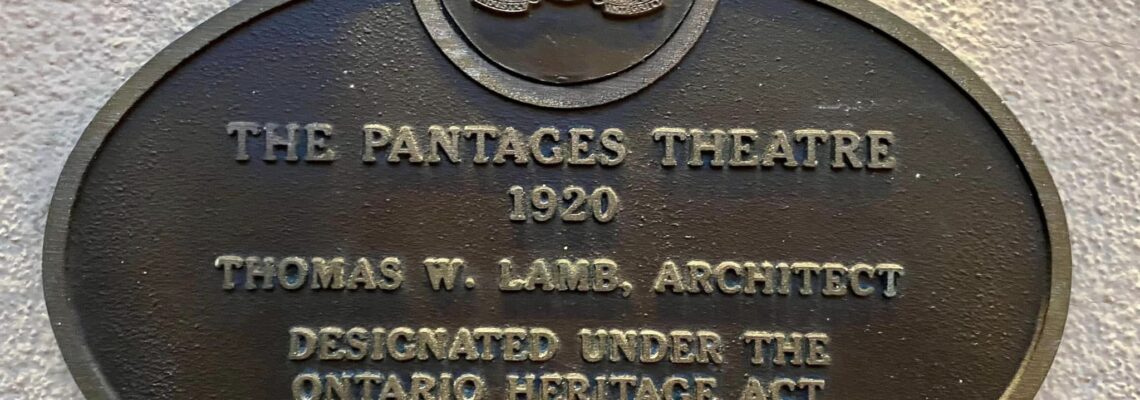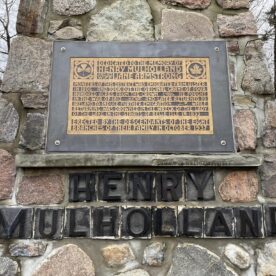The Pantages Theatre (aka the Imperial, the Canon, the CAA Ed Mirvish Theatre) was built in Toronto in 1920 by architect Thomas W. Lamb as a combination vaudeville and motion picture venue.
Lamb also built the nearby Elgin & Winter Garden Theatres (1913). Both were designed with a small footprint on expensive high-traffic prime real estate Yonge Street with the main theatres on nearby Victoria Street.
When it opened on August 28, 1920 it was the largest cinema in Canada at the time with 3,373 seats. Construction of the theatre was commissioned by Famous Players founder Nathan Nathanson, but it was known the Pantages Theatre after Alexander Pantages who managed the venue. Pantages ran an extensive vaudeville theatre circuit, with this theatre being the easternmost locale.
The name was changed to The Imperial after the theatre went out of Pantages hands in 1930 and full control was taken over by Famous Players. At this time the theatre became a movie house only. My great-uncle George Partridge worked here as a young man around the time the theatre became The Imperial; it was a memory he spoke of with pride when he took family to see movies at the theatre later in life. The Imperial continued until 1972 when it was renovated into six theatres, and became known as The Imperial Six upon reopening in 1973.
In the 1980s there was a rather contentious and complicated legal scuffle between Famous Players and Cineplex Odeon, who had been able to get their hands on half the theatre. Literally half – each company owned half of the dome! Both companies were unable to access some of the theatre spaces and projection rooms that they owned; it was a mess. In 1987 Cineplex Odeon considered demolishing their half but instead opened the 800 Pantages Theatre on their part of the property with an entrance off Victoria Street, as they had no access to the Yonge Street portion. When Famous Players made a move to demolish their half of the theatre, the Toronto Heritage Board stepped in, requesting that the building be preserved.
In 1988 Famous Players sold their half to Cineplex Odeon on the condition that no movies would be shown. Between 1988 and 1989 renovations removed the partition walls and restored the original plasterwork. Fortunately, and surprisingly, all the renovations had done minimal damage to the main structure of the theatre. Where restoration was not possible, architects and designers carefully replicated the original designs which included recreating the grand staircase, the Yonge Street ticket box, and the marquee and canopy on Yonge Street.
Upon reopening in September 1989, the theatre was renamed the Pantages Theatre. The first show after reopening was the Canadian premiere of Phantom of the Opera. I remember coming here to see that show as a teenager. I recall thinking the theatre was beautiful, but had no idea of its history. My dad bought me a black leather Pantages bookmark, which I still have today. It is in the shape of the marquee on Yonge Street, which is highly recognizable even though the name has changed today.
In 2001, the theatre became known as the Canon followed by another renaming in 2011 when it became known as the Ed Mirvish Theatre, and finally the most recently change in 2021 with addition of CAA. Personally, I will always call it the Pantages, just like Meridian Hall/Sony Centre/Hummingbird Centre will always be the O’Keefe Centre and the Rogers Centre will forever be known as the SkyDome.
On October 1, 1979, the City of Toronto listed the property on the City of Toronto Heritage Property Inventory thus preserving the original facades and exterior appearance of the property. On June 13, 1988, the property was designated under the Ontario Heritage Act, resulting in greater heritage protection for the theatre.![]() Today the theatre has approximately 2300 seats.
Today the theatre has approximately 2300 seats.
In recent years I’ve seen a few shows here, the three most recent being Annie, Harry Potter and the Cursed Child and just today, Chicago. Here are a few pictures from these recent visits, as well as a few historical pictures. It is one of Toronto’s treasures.





Leave a Reply